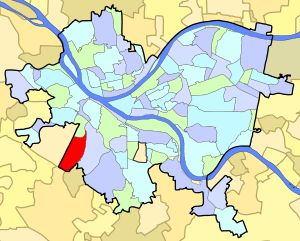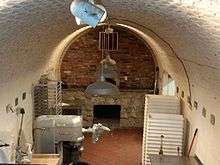Banksville (Pittsburgh)
| Banksville | |
|---|---|
| Neighborhood of Pittsburgh | |
 | |
| Coordinates: 40°24′43″N 80°02′20″W / 40.412°N 80.039°W | |
| Country | United States |
| State | Pennsylvania |
| County | Allegheny County |
| City | Pittsburgh |
| Area[1] | |
| • Total | 0.969 sq mi (2.51 km2) |
| Population (2010)[1] | |
| • Total | 4,144 |
| • Density | 4,300/sq mi (1,700/km2) |
Banksville is a neighborhood in Pittsburgh, Pennsylvania (20th ward). The neighborhood of Banksville is located in the western part of the city and borders the South Hills region. Real estate agencies frequently refer to the Banksville area as Greentree City due to Banksville's shared border with the borough of Green Tree. It has two zip codes of both 15220 and 15216, and has representation in Pittsburgh City Council by the council member for District 2 (West Neighborhoods). Theresa Kail-Smith is the current Councilperson for district two. Banksville's primary corridor, Banksville Road, is frequently used as a gateway between the South Hills of Pittsburgh and downtown Pittsburgh via the Fort Pitt Tunnels. Banksville, formerly Union Township, joined the City of Pittsburgh around 1928.
History
The building to the right, now converted to a restaurant, housed the fans used to control the air flow in Hartley Marshall's Enterprise Mine.

The first known European inhabitant of Banksville was Isaac Sellers, who settled in the area in 1773. According to the "History of Allegheny County", "the earliest settlers were subjected to frequent alarms by marauding Indians." Shortly after his settlement, he was joined by James Kearns and William Chess, both from Ireland.[2] The 400-acre (1.6 km2) land, known as "The Experiment" and located on the waters of Little Saw-Mill Run, was sold in 1784 to David and Agnes Carnahan of Ireland. Just before David's death, 250 acres (1.0 km2) of the land was split between David's 3 children—William, Alexander and Joseph.[3] The land was named Banksville by Alexander Carnahan (1789–1879) in honor of the family of his second wife — Eliza Banks.[4]
Alexander Carnahan laid out Banksville just after the Civil War. The town was a farming community as well as a prosperous mining town whose settlers were mostly Scotch-Irish.
The Little Saw Mill Run Railroad, owned by the Harmony Society, was operated between Banksville and the West End beginning in April 1853.
Banksville was formerly a part of Union Township before being annexed into the city of Pittsburgh in 1907.[5]
Banksville Related Mining activities: Coal Ridge Mine; Venture Mine, operated by Gray and Bell; Enterprise Mine, operated by Hartley and Marshall; Pittsburgh, Carnegie and Western Railroad; Westside Belt Railroad Company.
Community organizations
- Banksville Civic Association
Recreation
Residents have convenient access to the Banksville park, operated by the Pittsburgh Citiparks. The park features a playground, swimming pool, tennis courts, basketball court, batting cages, and ballfield.
Surrounding communities
Beechview, Dormont (a neighboring borough), Green Tree (a neighboring borough), Mt. Lebanon (a neighboring municipality), Ridgemont
See also
References
- 1 2 "PGHSNAP 2010 Raw Census Data by Neighborhood". Pittsburgh Department of City Planning PGHSNAP Utility. 2012. Retrieved 21 June 2013. External link in
|publisher=(help) - ↑ History of Allegheny County, Pennsylvania. 1899.
- ↑ Cushing, Thomas (2000). A Genealogical and Biographical History of Allegheny County, Pennsylvania.
- ↑ "City of Pittsburgh - Banksville". Archived from the original on January 6, 2011. Retrieved October 2, 2010.
- ↑ "Map of Union Township". 1896. Retrieved October 2, 2010.
Further reading
- Toker, Franklin (1994) [1986]. Pittsburgh: An Urban Portrait. Pittsburgh: University of Pittsburgh Press. ISBN 0-8229-5434-6.
External links
| Wikimedia Commons has media related to Banksville (Pittsburgh). |
- Interactive Pittsburgh Neighborhoods Map
- Historic Map of Banksville
- Report of Progress of Banksville Mine
- Picture of Banksville Saloon
- Painting of Banksville
- Banksville School News Article
- Photo and oil painting of Simmons farm on Potomac Avenue